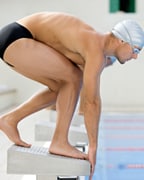Beneficios para la salud del ejercicio físico en el agua

La natación es la cuarta actividad deportiva más popular en los Estados Unidos y es una buena forma de hacer ejercicio aeróbico con regularidad 1. Tan solo dos horas y media de actividad aeróbica por semana, como nadar, andar en bicicleta o correr, pueden reducir el riesgo de presentar enfermedades crónicas 2, 3. También puede mejorar la salud de las personas que tienen diabetes o enfermedades cardiacas 2. En comparación con personas inactivas, el riesgo de muerte de los nadadores es casi la mitad 3. Las personas dicen que disfrutan más hacer ejercicio en el agua que en tierra firme 4. También pueden hacerlo por más tiempo, sin aumentar el esfuerzo ni los dolores de los músculos o las articulaciones 5, 6.
Referencias
- US Census Bureau. Statistical Abstract of the United States: 2012. Arts, Recreation, and Travel: Participation in Selected Sports Activities 2009. [XLS – 40 KB]
- U.S. Department of Health and Human Services. 2008 Physical Activity Guidelines for Americans: Be active, healthy, and happy! In Chapter 2: Physical Activity Has Many Health Benefits. 2009.
- Chase NL, Sui X, Blair SN. 2008. Swimming and all-cause mortality risk compared with running, walking, and sedentary habits in men. Int J of Aquatic Res and Educ. 2(3):213-23.
- Lotshaw AM, Thompson M, Sadowsky S, Hart MK, and Millard MW. Quality of life and physical performance in land- and water-based pulmonary rehabilitation. J Cardiopulm Rehab. 2007;27:247-51.
- Broman G, Quintana M, Engardt M, Gullstrand L, Jansson E, and Kaijser L. Older women’s cardiovascular responses to deep-water running. J Aging Phys Act. 2006;14(1):29-40.
- Cider A, Svealv BG, Tang MS, Schaufelberger M, and Andersson B. Immersion in warm water induces improvement in cardiac function in patients with chronic heart failure. Eur J Heart Fail. 2006;8(3):308-13.
- Westby MD. A health professional’s guide to exercise prescription for people with arthritis: a review of aerobic fitness activities. Arthritis Rheum. 2001;45(6):501-11.
- Hall J, Skevington SM, Maddison PJ, Chapman K. A randomized and controlled trial of hydrotherapy in rheumatoid arthritis. Arthritis Care Res. 1996;9(3):206-15.
- Bartels EM, Lund H, Hagen KB, Dagfinrud H, Christensen R, Danneskiold-Samsøe B. Aquatic exercise for the treatment of knee and hip osteoarthritis. Cochrane Database Syst Rev. 2016;3:CD005523.
- Berger BG, and Owen DR. Mood alteration with yoga and swimming: aerobic exercise may not be necessary. Percept Mot Skills. 1992;75(3 Pt 2):1331-43.
- Tomas-Carus P, Gusi N, Hakkinen A, Hakkinen K, Leal A, and Ortega-Alonso A. Eight months of physical training in warm water improves physical and mental health in women with fibromyalgia: a randomized controlled trial. J Rehabil Med. 2008;40(4):248-52.
- Gowans SE and deHueck A. Pool exercise for individuals with fibromyalgia. Curr Opin Rheumatol. 2007;19(2):168-73.
- Hartmann S and Bung P. Physical exercise during pregnancy—physiological considerations and recommendations. J Perinat Med. 27(3):204-15.
- Mactavish JB and Schleien SJ. Re-injecting spontaneity and balance in family life: parents’ perspectives on recreation in families that include children with developmental disability. J Intellect Disabil Res. 2004;48(Pt 2):123-41.
- Sato D, Kaneda K, Wakabayashi H, and Nomura T. The water exercise improves health-related quality of life of frail elderly people at day service facility. Qual Life Res. 2007;16:1577-85.
- Rotstein A, Harush M, and Vaisman N. The effect of water exercise program on bone density of postmenopausal Women. J Sports Med Phys Fitness. 2008;48(3):352-9.